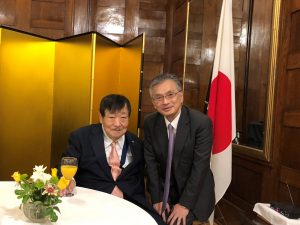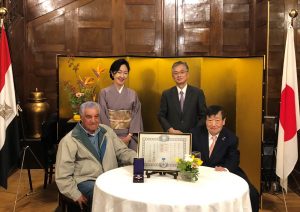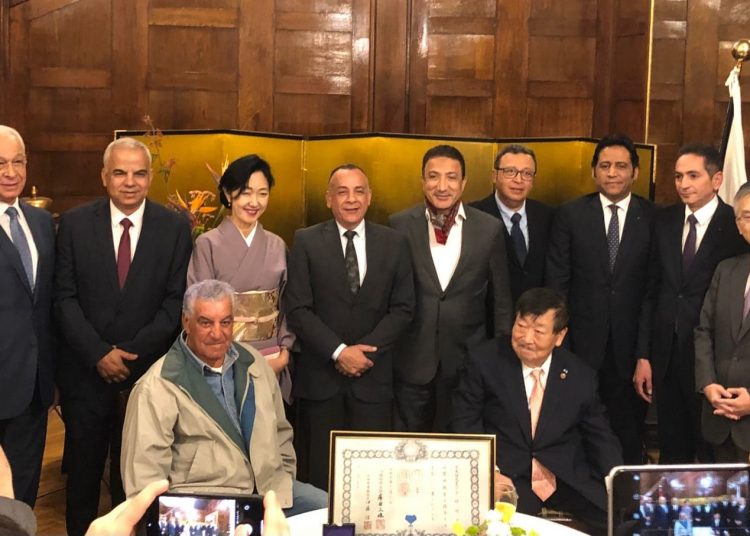As a child, Sakuji Yoshimura read about the discovery of Tutankhamun’s tomb by British archaeologist Howard Carter in 1922.
Since then, he has dreamt of becoming an archaeologist like Carter.
After attending Waseda University, Yoshimura spent a year surveying all major monuments in ancient Egypt, from Alexandria to Abu Simbel.
This was the first ever field study of its kind carried out by a Japanese person.
“During this research, I realised that Egypt deserves that I dedicate my whole life to it,” said Japanese Egyptologist Yoshimura, President Higashi Nippon International University.
The above was part of a documentary about Yoshimura displayed in an event held at the Japanese Ambassador’s residence in Cairo to celebrate his being awarded the Decoration of the Order of the Sacred Treasure, Gold Rays with Neck Ribbon, by the Emperor of Japan for his achievements in academic exchanges and promotion of cooperation for scientific research between Japan and Egypt over many years.
Yoshimura had started his excavation activities in Egypt in 1966. Since then, he has conducted several joint archaeological excavation projects and his team is continuing its archaeological activities on the fields today.
“The list of his achievements is countless, and his successful achievement is made possible by his devotion to Egyptology, who has opened ways singlehandedly as a pathfinder,” Ambassador Oka Hiroshi said.

“Whoever is acquainted with him would be touched by his strong curiosity to pursue the truth in the long history of humankind. But his success is equally supported by many of his friends in Egypt who all admire and are emphasised by his passion and devotion,” he added.
In this sense, the ambassador went on to say, his decoration is also about the trust and friendship he and his Egyptian friends have cultivated over these years.
Among his numerous achievements is the project, which is internationally highly acclaimed, to excavate and restore the Second Khufu Boat in co-operation with experts of both countries and with the support of Japan International Cooperation Agency.
“The excavation of the Second Khufu Boat was made possible by the permission of Zahi Hawass, the then Supreme Council of Antiquities’ Secretary General. The fact that the permission was granted under the strict control of the Egyptian government, I believe, reflects the confidence that Yoshimura has built up with the Egyptian government and the Egyptian archaeological communities,” Oka said.
In the future, he added, the Second Khufu Boat will be exhibited as one of the feature exhibits of the Grand Egyptian Museum, a national project which is being developed as a new symbol of cooperation between Egypt and Japan.
Preceding the decoration from Emperor of Japan, Yoshimura was given many awards which include Japanese Foreign Minister’s Commendations in 2023 as well as the award presented at the International Congress of Egyptologists in 2019 at Cairo from then Minister of Antiquities Khalid el-Anany.
The ambassador said that Yoshimura, who is Emeritus Professor of Waseda University, has made numerous television appearances, published many books, and given lectures in Japan.
“These activities have helped to promote mutual understanding between the peoples of the two countries, as interest in Egyptian archaeology is extremely high in Japan,” he said.
When Yoshimura decided to carry out excavations in Egypt, he joined Cairo University after graduating from Waseda University, where he worked hard to obtain rights to archaeological excavation, while studying Egyptology.
In 1970, he obtained the right to archaeological excavation, which he began in the south of Malkata on the west bank of Luxor.
Four years later, he made his first major discovery which was coloured stairs of the Heb Sed Court, which was built by King Amenhotep III of the 18th Dynasty. This discovery brought his team to the attention of the world.
After that, Yoshimura set to work a comparative study of the Tombs of the Nobles from the 18 Dynasty in order to develop his research. He unearthed a large number of mummies from there.
After obtaining permission from the Egyptian government, Yoshimura took some of these mummies to Japan and examined a facial skeleton using CT scans. Based on this data, he restored the shape of the mummy’s owner’s face when he was alive.
In 2019, Yoshimura worked to solve the mystery of the unknown voids inside the Khufu (Cheops) Pyramid.

Previously in 1987, he detected the presence of empty spaces inside the pyramid using ground-penetrating radar, but now he is using new exploration equipment to try to uncover the secrets of the pyramid again.
Famed archaeologists Zahi Hawass and Supreme Council of Antiquities’ (SCA) Secretary General Mostafa Waziry attended the celebration on November 30.
It was announced that a huge archaeological project in the Pyramids area will be carried out by the joint Japanese-Egyptian mission in the near future.
The Egyptian side is headed by Waziry and the Japanese by Yoshimura.
The project is to reinstall the outer granite block covering around the Menkaure pyramid that has fallen over time and return it as it was in the time of the ancient Egyptian.
Yoshimura, now 80, is still in search of new discoveries.






Discussion about this post